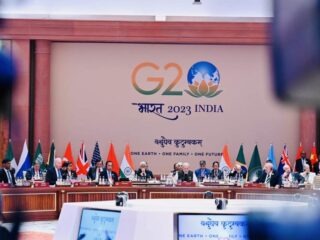Asghar Ali Engineer
(Secular Perspective August 1-15, 2010)
Hijab controversy in Europe refuses to die down. With the French Parliament legislating against it, it has acquired new lease of life. More and more is being written on it in the print media and is being discussed repeatedly in electronic media also. The debate has become quite lively as some, including Muslim women, are opposing hijab and some, including non-Muslims, especially human rights activists in the west, are opposing the ban and criticizing those countries who have legislated against it.
We have to look at it from religious, cultural, sociological and political angles to understand the whole controversy comprehensively. First let us have a look from religious angle. The Qur’an no where mentions hijab for Muslim women except for the wives of the Prophet whom Muslims consider mothers of believers (Ummhat al-mu’minin). Qur’an advises Muslims to talk to them from behind a curtain because many who came to the Prophet’s house for marriage dinner indulged in loose talk with them which was not appreciated by the Prophet (PBUH)
As for ordinary Muslim women there is no mention of the hijab at all, certainly not the face veil. They are advised not to display their adornments (zeenah) publicly and display what should remain open (ma zahara minha) i.e. face and hands. It also advises women to cover their bosom with piece of cloth (khimar) slung across their shoulders or used for covering heads. This is near consensus among the Ulama. However, a minority of jurists, especially the Hanbalites insist that face should also be covered. After the controversy now a Saudi mufti belonging to Hanbali School has also issued a fatwa that in Europe where this controversy is raging and a ban is being imposed, Muslim women can keep their face open.
Face veil is not worn by Muslim women in all Muslim or non-Muslim countries. While in Saudi Arabia women wear abaya (a loose over-garment) and cover their face, in Gulf countries women have freedom to choose their dress and many women even cut their hair and display it and work freely in Govt. and private offices and drive car which is a taboo in Saudi Arabia. In Pakistan many women do not cover their heads except on certain occasions. In India, which has a largest Muslim minority, Muslim women have much greater freedom.
Hijab is much more cultural than religious and its design, shape and form varies from culture to culture. Except in Saudi Arabia only a small number of women observe face veil. Even in France which has banned face veil no more than 400 to 2000 Muslim women wear face veil out of a population of six million Muslims. And it is this tiny minority of Muslim women have frightened the French population.
From cultural angle we have to take Western culture into account too. Until early 20th century European women also used to cover their body including their legs. And Christian nuns are required to cover their heads until now. However, with women’s liberation the legs began to be exposed and subsequently even a part of the breasts were also exposed and for urban elite that became a norm. A woman after fifties of last century acquired much greater freedom to expose their bodies.
Initially those Muslims who migrated to Europe along with their families were mostly from working class and not so much literate and adhered to their cultural norms which, in general, did not include face veil. Muslims mostly from rural areas of Turkey, Pakistan and western African countries migrated to Europe including France. Their women mostly remained confined to their families and were not seen much in public spaces.
However, things began to change for two reasons: firstly the number of migrants began to increase and now it was not from working class but from highly qualified sections that began to migrate. They were much more identity conscious and this feeling of identity became more acute when they faced racial prejudices and marginalization in the job market. Also, they found it difficult to assimilate with new culture in the west.
They began to adhere more strictly to their own cultural norms. After oil revolution in the Middle East in early seventies, Islam became much more visible in the west and a large number of Arabs began to flock to Europe to spend their newly acquired riches. They brought along their families and Muslim women with their cultural gears began to be seen in ever larger numbers in public spaces.
Initially they were seen with curiosity rather than with resentment. However, soon curiosity turned into resentment and also cultural shock for western people as their women were acquiring more liberty in exposing parts of their body. This was quite natural when two strange culture meet with such difference it does result in cultural shock. And it turned into complete resentment when western women’s dress became more and more scanty and Muslim women’s dress covering greater and greater parts of body including the face.
Also, after 9/11 it did not remain mere cultural resentment and shock but it acquired political overtones. Now Islam began to be seen as outright threat to security of the west. Thus cultural threat turned into political threat and Huntington’s clash of civilization appeared to be more real than a mere socio-political theorization. And as it acquired political overtones, Muslims began to be seen with suspicion and felt ever more isolated than before. Wearing veil increased this suspicion though a tiny minority observed it.
Though a tiny minority observes it but being much more visible as an identity marker this fact was neglected that for every woman wearing veil there were thousands who never did. And after 9/11 it began to be seen not only as religious fanaticism but also a security threat. Who is behind the veil? A terrorist woman, or even man, hiding the bomb. And some women, going to extreme, refused to lift their veil inciting more fear. And hence anti-hijab movement acquired much more serious proportions.
Then there is human rights angle. Can a woman be forced to wear or not to wear a particular dress? Those in favour of ban argue that she is coerced by her family to wear face veil and this is also violation of her human right. Yes, it is true in few cases but it is also true that often she wears face veil of her own choice. How to determine what is the truth unless she herself complains of any such coercion?
But banning face veil can result, in many cases, in double oppression for women. If she is being coerced into wearing face veil she faces oppression from her family and if she is penalized or jailed for wearing veil she faces state oppression too, for no fault of hers. Thus she, as if, goes from one jail to another jail. Thus state rather than liberating her ends up oppressing her even more.
Also, the argument that French culture or for that matter culture of any other European country like Belgium which also has banned it, is secular and that face veil is threat to their secular culture is no more valid. France, Belgium, Switzerland or any other European country are no more mono-cultural. They are all multi-cultural and multi-culturalism should be the new yardstick for behavioral norms
The west projected itself so far as highly tolerant and east as less tolerant. But the fact is that east has always been multi-cultural and multi-religious and much more tolerant. West which was all along mono-cultural and mono-religious could boast of more tolerance but now that it is becoming multi-cultural its limits of tolerance are being exposed. It was always racially intolerant but now Afro-Asian minorities are facing not only racial but cultural intolerance also.
Politically also there is an increasing challenge. Sarkozy is out to ban veil not only because of secular culture of France but because he is basically rightwing politician and wants to cater to political perceptions of his rightwing constituency. The economic crisis in the west is also forcing hands of these politicians. To meet these political challenges they try to invoke their secular narrative precisely as some Muslims resort to religious narrative to legitimize their identity and economic marginalization.
But let us not forget these are temporary problems. A new reality is also coming into existence which cannot be ignored. There is already a new identity being borne at least as far as new generation of Muslims borne in Europe is concerned. This new generation does not fall into category of migrants as they have been borne and brought up in Europe. A new term Euro-Islam is on the horizon though yet not a strong trend.
Nevertheless it is an emerging trend. Though parents are worried that this generation is losing their culture, even language and are desperate to reinvent it for their children but they are fighting a loosing battle. This Euro-Islam will be definitely different from Asian and African Islam and will be culturally more European-Western than Afro-Asian. Even new theologians will emerge from amongst them.
However, this transitional period has its own challenges which must be met creatively than conflictually. When a new reality is borne transitional period has to be handled much more sensitively and it is both for the present generation of Europeans and migrant Muslims that they appreciate these challenges and handle them sensitively they deserve.
————————————————
Centre for Study of Society and Secularism
Mumbai.




